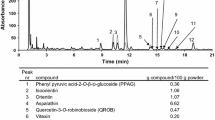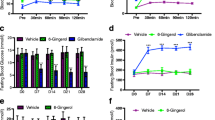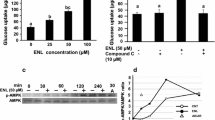Abstract
There have been studies on health beneficial effects of ginger and its components. However, there still remain certain aspects that are not well defined in their anti-hyperglycemic effects. Our aims were to find evidence of possible mechanisms for antidiabetic action of [6]-gingerol, a pungent component of ginger, employing a rat skeletal muscle-derived cell line, a rat-derived pancreatic β-cell line, and type 2 diabetic model animals. The antidiabetic effect of [6]-gingerol was investigated through studies on glucose uptake in L6 myocytes and on pancreatic β-cell protective ability from reactive oxygen species (ROS) in RIN-5F cells. Its in vivo effect was also examined using obese diabetic db/db mice. [6]-Gingerol increased glucose uptake under insulin absent condition and induced 5′ adenosine monophosphate-activated protein kinase phosphorylation in L6 myotubes. Promotion by [6]-gingerol of glucose transporter 4 (GLUT4) translocation to plasma membrane was visually demonstrated by immunocytochemistry in L6 myoblasts transfected with glut4 cDNA-coding vector. [6]-Gingerol suppressed advanced glycation end product-induced rise of ROS levels in RIN-5F pancreatic β-cells. [6]-Gingerol feeding suppressed the increases in fasting blood glucose levels and improved glucose intolerance in db/db mice. [6]-Gingerol regulated hepatic gene expression of enzymes related to glucose metabolism toward decreases in gluconeogenesis and glycogenolysis as well as an increase in glycogenesis, thereby contributing to reductions in hepatic glucose production and hence blood glucose concentrations. These in vitro and in vivo results strongly suggest that [6]-gingerol has antidiabetic potential through multiple mechanisms.



Similar content being viewed by others
Abbreviations
- AMPK:
-
5′ Adenosine monophosphate-activated protein kinase
- GLUT4:
-
Glucose transporter 4
- G6Pase:
-
Glucose-6-phosphatase
- GS:
-
Glycogen synthase
- LGP:
-
Liver glycogen phosphorylase
- PEPCK:
-
Phosphoenolpyruvate carboxykinase
- TBARS:
-
Thiobarbituric acid-reactive substances
- TC:
-
Total cholesterol
- TG:
-
Triglyceride
References
Al-Amin ZM, Thomson M, Al-Qattan KK, Peltonen-Shalaby R, Ali M (2006) Anti-diabetic and hypolipidaemic properties of ginger (Zingiber officinale) in streptozotocin-induced diabetic rats. Br J Nutr 96:660–666
Bełtowski J, Wójcicka G, Górny D, Marciniak A (2000) The effect of dietary-induced obesity on lipid peroxidation, antioxidant enzymes and total plasma antioxidant capacity. J Physiol Pharmacol 51:883–896
Chakraborty D, Mukherjee A, Sikdar S, Paul A, Ghosh S, Khuda-Bukhsh AR (2012) [6]-Gingerol isolated from ginger attenuates sodium arsenite induced oxidative stress and plays a corrective role in improving insulin signaling in mice. Toxicol Lett 210:34–43
Cheong SH, Furuhashi K, Ito K, Nagaoka M, Yonezawa T, Miura Y, Yagasaki K (2014) Antihyperglycemic effect of equol, a daidzein derivative, in cultured L6 myocytes and ob/ob mice. Mol Nutr Food Res 58:267–277
Chomczynski P, Sacchi N (1987) Single-step method of RNA isolation by acid guanidinium thiocyanate-phenol-chloroform extraction. Anal Biochem 162:156–159
Del Prato S, Marchetti P (2004) Targeting insulin resistance and beta-cell dysfunction: the role of thiazolidinediones. Diabetes Technol Ther 6:719–731
Dugasani S, Pichika MR, Nadarajah VD, Balijepalli MK, Tandra S, Korlakunta JN (2010) Comparative antioxidant and anti-inflammatory effects of [6]-gingerol, [8]-gingerol, [10]-gingerol and [6]-shogaol. J Ethnopharmacol 127:515–520
Fecchi K, Volonte D, Hezel MP, Schmeck K, Galbiati F (2006) Spatial and temporal regulation of GLUT4 translocation by flotillin-1 and caveolin-3 in skeletal muscle cells. FASEB J 20:705–707
Fiorentino TV, Prioletta A, Zuo P, Folli F (2013) Hyperglycemia-induced oxidative stress and its role in diabetes mellitus related cardiovascular diseases. Curr Pharm Des 19:5695–5703
Ha BG, Nagaoka M, Yonezawa T, Tanabe R, Woo JT, Kato H, Chung UI, Yagasaki K (2012) Regulatory mechanism for the stimulatory action of genistein on glucose uptake in vitro and in vivo. J Nutr Biochem 23:501–509
Huang S, Czech MP (2007) The GLUT4 glucose transporter. Cell Metab 5:237–252
Huang C, Somwar R, Patel N, Niu W, Török D, Klip A (2002) Sustained exposure of L6 myotubes to high glucose and insulin decreases insulin-stimulated GLUT4 translocation but upregulates GLUT4 activity. Diabetes 51:2090–2098
Imamura T, Huang J, Usui I, Satoh H, Bever J, Olefsky JM (2003) Insulin-induced GLUT4 translocation involves protein kinase C-λ-mediated functional coupling between Rab4 and the motor protein kinesin. Mol Cell Biol 23:4892–4900
Kawano A, Nakamura H, Hata S, Minakawa M, Miura Y, Yagasaki K (2009) Hypoglycemic effect of aspalathin, a rooibos tea component from Aspalathus linearis, intype 2 diabetic model db/db mice. Phytomedicine 16:437–443
Krook A, Wallberg-Henriksson H, Zierath JR (2004) Sending the signal: molecular mechanisms regulating glucose uptake. Med Sci Sports Exerc 36:1212–1217
Kubra IR, Rao LJ (2012) An impression on current developments in the technology, chemistry, and biological activities of ginger (Zingiber officinale Roscoe). Crit Rev Food Sci Nutr 52:651–688
Kume S, Kato S, Yamagishi S, Inagaki Y, Ueda S, Arima N, Okawa T, Kojiro M, Nagata K (2005) Advanced glycation end-products attenuate human mesenchymal stem cells and prevent cognate differentiation into adipose tissue, cartilage, and bone. J Bone Miner Res 20:1647–1658
Li Y, Tran VH, Koolaji N, Duke C, Roufogalis BD (2013) (S)-[6]-Gingerol enhances glucose uptake in L6 myotubes by activation of AMPK in response to [Ca2+] i . J Pharm Pharm Sci 16:304–312
Lin N, Zhang H, Su Q (2012) Advanced glycation end-products induce injury to pancreatic beta cells through oxidative stress. Diabetes Metab 38:250–257
Miele C, Riboulet A, Maitan MA, Oriente F, Romano C, Formisano P, Giudicelli J, Beguinot F, Van Obberghen E (2003) Human glycated albumin affects glucose metabolism in L6 skeletal muscle cells by impairing insulin-induced insulin receptor substrate (IRS) signaling through a protein kinase C alpha-mediated mechanism. J Biol Chem 278:47376–47387
Minakawa M, Kawano A, Miura Y, Yagasaki K (2011) Hypoglycemic effect of resveratrol in type 2 diabetic model db/db mice and its actions in cultured L6 myotubes and RIN-5F pancreatic β-cells. J Clin Biochem Nutr 48:237–244
Minakawa M, Miura Y, Yagasaki K (2012) Piceatannol, a resveratrol derivative, promotes glucose uptake through glucose transporter 4 translocation to plasma membrane in L6 myocytes and suppresses blood glucose levels in type 2 diabetic model db/db mice. Biochem Biophys Res Commun 422:469–475
Nishitani S, Matsumura T, Fujitani S, Sonaka I, Miura Y, Yagasaki K (2002) Leucine promotes glucose uptake in skeletal muscles of rats. Biochem Biophys Res Commun 299:693–696
Park SJ, Ahmad F, Philp A, Baar K, Williams T, Luo H, Ke H, Rehmann H, Taussig R, Brown AL, Kim MK, Beaven MA, Burgin AB, Manganiello V, Chung JH (2012) Resveratrol ameliorates aging-related metabolic phenotypes by inhibiting cAMP phosphodiesterases. Cell 148:421–433
Reagan-Shaw S, Nihal M, Ahmad N (2008) Dose translation from animal to human studies revisited. FASEB J 22:659–661
Saltiel AR, Kahn CR (2001) Insulin signalling and the regulation of glucose and lipid metabolism. Nature 414:799–806
Singh AB, Akanksha Singh N, Maurya R, Srivastava AK (2009) Anti-hyperglycaemic, lipid lowering and anti-oxidant properties of [6]-gingerol in db/db mice. Int J Med Med Sci 1:536–544
Son MJ, Minakawa M, Miura Y, Yagasaki K (2013) Aspalathin improves hyperglycemia and glucose intolerance in obese diabetic ob/ob mice. Eur J Nutr 52:1607–1619
Tan KC, Shiu SW, Wong Y, Tam X (2011) Serum advanced glycation end products (AGEs) are associated with insulin resistance. Diabetes Metab Res Rev 27:488–492
Tiedge M, Lortz S, Drinkgern J, Lenzen S (1997) Relation between antioxidant enzyme gene expression and antioxidative defense status of insulin-producing cells. Diabetes 46:1733–1742
Unoki H, Bujo H, Yamagishi S, Takeuchi M, Imaizumi T, Saito Y (2007) Advanced glycation end products attenuate cellular insulin sensitivity by increasing the generation of intracellular reactive oxygen species in adipocytes. Diabetes Res Clin Pract 76:236–244
Wautier JL, Guillausseau PJ (2001) Advanced glycation end products, their receptors and diabetic angiopathy. Diabetes Metab 27:535–542
Winkler G, Kiss S, Keszthelyi L, Sápi Z, Ory I, Salamon F, Kovács M, Vargha P, Szekeres O, Speer G, Karádi I, Sikter M, Kaszás E, Dworak O, Gerö G, Cseh K (2003) Expression of tumor necrosis factor (TNF)-α protein in the subcutaneous and visceral adipose tissue in correlation with adipocyte cell volume, serum TNF-α soluble serum TNF-receptor-2 concentrations and C-peptide level. Eur J Endocrinol 149:129–135
Yagasaki K, Morisaki N, Kitahara Y, Miura A, Funabiki R (2003) Involvement of proteinkinase C activation in l-leucine-induced stimulation of protein synthesis in L6 myotubes. Cytotechnology 43:97–103
Yagihashi S, Miura Y, Yagasaki K (2008) Inhibitory effect of gingerol on the proliferation and invasion of hepatoma cells in culture. Cytotechnology 57:129–136
Zhou G, Myers R, Li Y, Chen Y, Shen X, Fenyk-Melody J, Wu M, Ventre J, Doebber T, Fujii N, Musi N, Hirshman MF, Goodyear LJ, Moller DE (2001) Role of AMP-activated protein kinase in mechanism of metformin action. J Clin Invest 108:1167–1174
Acknowledgments
This work was supported in part by the Japan Science Society and in part by the Asahi Group Foundation, Tokyo, Japan.
Conflict of interest
Authors declare that they have no conflict of interest.
Author information
Authors and Affiliations
Corresponding author
Electronic supplementary material
Below is the link to the electronic supplementary material.
Rights and permissions
About this article
Cite this article
Son, M.J., Miura, Y. & Yagasaki, K. Mechanisms for antidiabetic effect of gingerol in cultured cells and obese diabetic model mice. Cytotechnology 67, 641–652 (2015). https://doi.org/10.1007/s10616-014-9730-3
Received:
Accepted:
Published:
Issue Date:
DOI: https://doi.org/10.1007/s10616-014-9730-3




